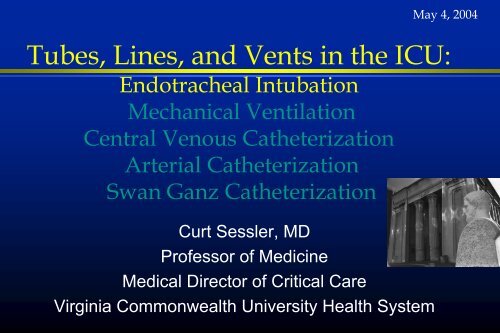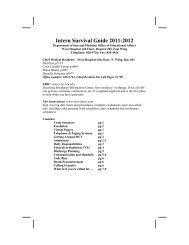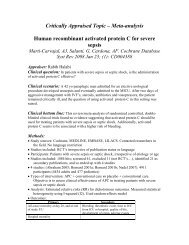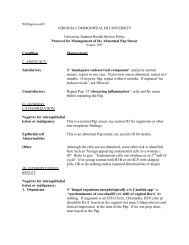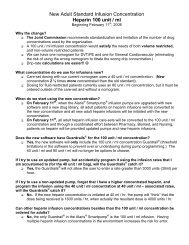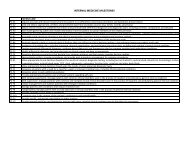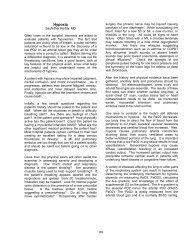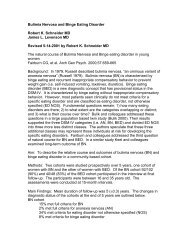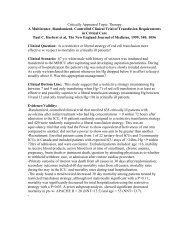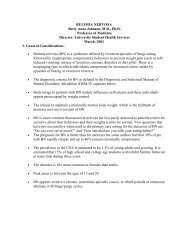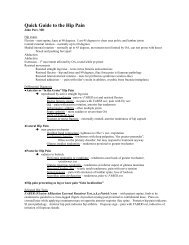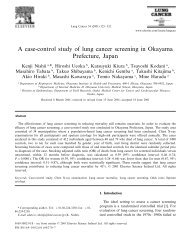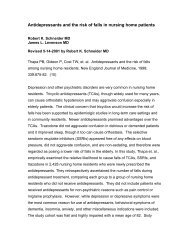Endotracheal Intubation - Virginia Commonwealth University
Endotracheal Intubation - Virginia Commonwealth University
Endotracheal Intubation - Virginia Commonwealth University
You also want an ePaper? Increase the reach of your titles
YUMPU automatically turns print PDFs into web optimized ePapers that Google loves.
May 4, 2004<br />
Tubes, Lines, and Vents in the ICU:<br />
<strong>Endotracheal</strong> <strong>Intubation</strong><br />
Mechanical Ventilation<br />
Central Venous Catheterization<br />
Arterial Catheterization<br />
Swan Ganz Catheterization<br />
Curt Sessler, MD<br />
Professor of Medicine<br />
Medical Director of Critical Care<br />
<strong>Virginia</strong> <strong>Commonwealth</strong> <strong>University</strong> Health System
<strong>Endotracheal</strong> <strong>Intubation</strong>: Outline<br />
• Anatomy<br />
• Preparation<br />
» Patient evaluation<br />
» Equipment / Medications<br />
• Pre-intubation patient management<br />
• Procedure of intubation<br />
• Difficult airway
Goals of <strong>Endotracheal</strong><br />
<strong>Intubation</strong><br />
• Secure and protect airway<br />
• Ventilation<br />
• Oxygenation
Anatomy for<br />
Tracheal <strong>Intubation</strong><br />
• Pathway to vocal<br />
cords: mouth,<br />
pharynx, larynx<br />
• Glottis: vocal cords,<br />
epiglottis, valeculae,<br />
esophagus
Pre-<strong>Intubation</strong> Patient<br />
Evaluation: Critical Issues<br />
• Difficult mask fit / bag-mask ventilation<br />
• Difficult intubation<br />
• Medical conditions which influence<br />
choice of medications<br />
• Alternative airway options
Pre-<strong>Intubation</strong> Evaluation:<br />
‘NDOTRAC’<br />
Parameter Abnormality Action<br />
N Neck Short Difficult*<br />
D Dentition Loose teeth Caution w blade<br />
O Oral cavity Small, limited view Difficult*<br />
T Tongue Large Difficult, curved blade<br />
R ROM Limited Fiberoptic<br />
A Adam’s apple Prominent (anterior) straight b<br />
C Chin Receding Difficult*<br />
* consider awake intubation, alternatives, backup
Equipment for <strong>Intubation</strong><br />
• Laryngoscope:<br />
handle, straight &<br />
curved blades<br />
• <strong>Endotracheal</strong> tubes<br />
• Airways<br />
• Water soluble<br />
lubricant<br />
• Stylet<br />
• Syringe<br />
• Suction equipment<br />
• Oxygen<br />
• Bag and mask<br />
• Pulse oximetry<br />
• ET CO2 detector<br />
• Tape / benzoin<br />
• Cardiac monitor<br />
• Defibrillator<br />
• Medications
Patient Preparation<br />
• Open airway by placing<br />
patient in sniffing position<br />
• Lift at chin or angles of<br />
jaw
Patient Preparation<br />
• Towel / blanket beneath<br />
head / upper shoulders<br />
• Provide effective mask<br />
ventilation with 100% O2<br />
» May need oral airway<br />
» May need PEEP valve<br />
• Apply pressure to cricoid cartilage
Visualize Vocal Cords<br />
• Align axes of pharynx, larynx, mouth<br />
• Place towels beneath head to align larynx & pharynx<br />
• Using laryngoscope, hyperextend at C1-C2 vertebra
Orotracheal <strong>Intubation</strong><br />
• Position patient in sniffing<br />
position, hyper-extend at C1-C2<br />
• Laryngoscope blade is inserted<br />
into the right corner of the mouth<br />
and advanced halfway as<br />
moved to the midline<br />
» Tongue swept out of the way<br />
» Epiglottis visualized
Orotracheal <strong>Intubation</strong><br />
• Curved blade: tip of blade<br />
advanced above epiglottis<br />
• Straight blade: tip of<br />
blade advanced under<br />
epiglottis<br />
• Laryngoscope lifted to<br />
visualize cords
Orotracheal <strong>Intubation</strong><br />
• ET tube tip is passed<br />
between cords until cuff is<br />
beyond cords
How to Hold the<br />
<strong>Endotracheal</strong> Tube?
Steps in Orotracheal<br />
<strong>Intubation</strong><br />
• Insert blade<br />
• Visualize epiglottis<br />
• Reposition blade<br />
and visualize<br />
vocal cords<br />
• Insert ET tube
Rapid Sequence <strong>Intubation</strong><br />
(RSI)<br />
• Short acting sedatives and neuromuscular<br />
blocking agent to facilitate immediate<br />
intubation in unstable patient<br />
• Features<br />
» Adequate sedation and amnesia<br />
» Rapid muscle relaxation<br />
» Reduced risk of aspiration<br />
» Reduced rise in ICP
Induction Agents<br />
• Smooth rapid amnestic<br />
• Short duration of action<br />
• Stable hemodynamics<br />
• Few side effects<br />
•Etomidate (Amidate)<br />
•Midazolam (Versed)<br />
•Thiopental (Pentothal)<br />
•Methohexital (Brevitol)<br />
•Ketamine (Ketalar)
Nasotracheal <strong>Intubation</strong><br />
• Patient selection<br />
» Must be spontaneously breathing<br />
• Useful alternative to orotracheal intubation<br />
» Cervical spine injury<br />
» Avoid IV sedatives and NMBA<br />
• Contra-indications: apnea, upper airway foreign<br />
body, bleeding diathesis, epiglottitis, CSF rhinorrhea /<br />
head trauma, nasal polyp or abscess
Nasotracheal <strong>Intubation</strong>:<br />
Technique<br />
• Determine nasal patency, consider<br />
applying vasoconstricting agent<br />
• Insert nasal airway coated<br />
with topical anesthetic /<br />
lubricant
Nasotracheal <strong>Intubation</strong>:<br />
Technique<br />
• With patient sitting upright, ET tube is<br />
inserted and advanced towards the back of<br />
the head above the hard pallet<br />
• ET tube advanced toward cords while<br />
listening for breath sounds
Nasotracheal <strong>Intubation</strong>:<br />
Technique<br />
• <strong>Endotracheal</strong> position confirmed by breath<br />
sounds through ET tube, cough.<br />
• Methods to improve successful placement<br />
» head in sniffing position<br />
» protrude tongue<br />
» cricoid pressure<br />
» maintain slight downward pressure if meeting<br />
resistance and patient cannot speak: tip likely is<br />
against cords and will pass when pt breathes
<strong>Endotracheal</strong> <strong>Intubation</strong>:<br />
Complications<br />
• Trauma: teeth, mouth,<br />
pharynx, nasopharynx,<br />
trachea<br />
• Esophageal intubation<br />
» Avoid by measuring<br />
exhaled CO2 (bag for<br />
5-10 breaths to confirm)
<strong>Endotracheal</strong> <strong>Intubation</strong>:<br />
Complications<br />
• Bronchial intubation<br />
» Confirm bilateral = BS<br />
» Confirm ET tube position<br />
• Reflex response to airway<br />
stimulation:<br />
» Tachycardia, hypertension,<br />
increased ICP resulting in MI,<br />
• Aspiration of gastric contents<br />
• Hypotension: dehydration,<br />
poor LV function<br />
22 cm<br />
27 cm
Difficult Airway:<br />
Esophageal Tracheal Tube<br />
Manually (blindly) inserted.<br />
Double lumen tube with 2<br />
cuffs. One tube (arrow)<br />
opens to multiple holes<br />
between cuffs and is used<br />
to ventilate if tip is in<br />
esophagus. Other lumen<br />
opens beyond distal cuff<br />
and is used to ventilate if<br />
tip is placed in trachea.<br />
Blanda. J Crit Illness 2000
Difficult Airway:<br />
Laryngeal Mask<br />
Manually (blindly)<br />
inserted. Slightly<br />
inflate cuff and insert<br />
to fit over the larynx.<br />
Inflate tube and bag.
Cricothyroidotomy /<br />
Transtracheal Ventilation
<strong>Endotracheal</strong> <strong>Intubation</strong>:<br />
Summary<br />
• Preparation for intubation<br />
» Patient assessment<br />
» Equipment<br />
» <strong>Intubation</strong><br />
• <strong>Endotracheal</strong> intubation procedure<br />
» Pre-intubation<br />
» Procedure<br />
• Difficult airway management


